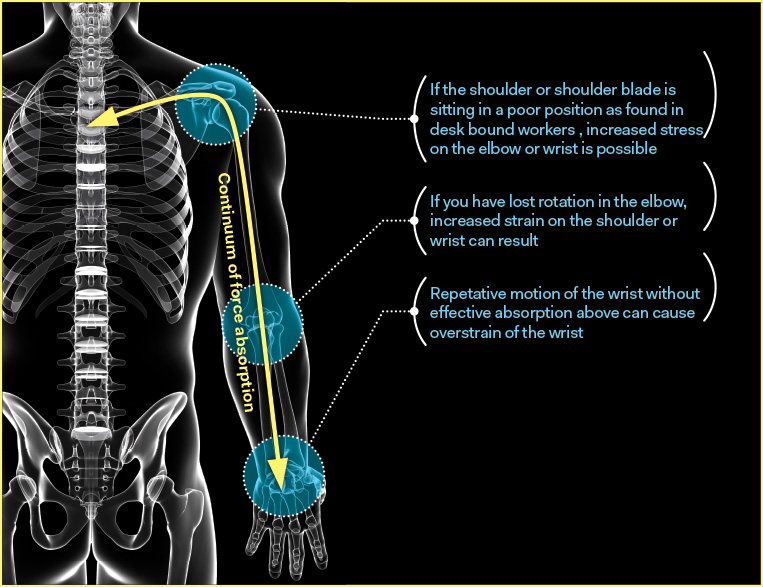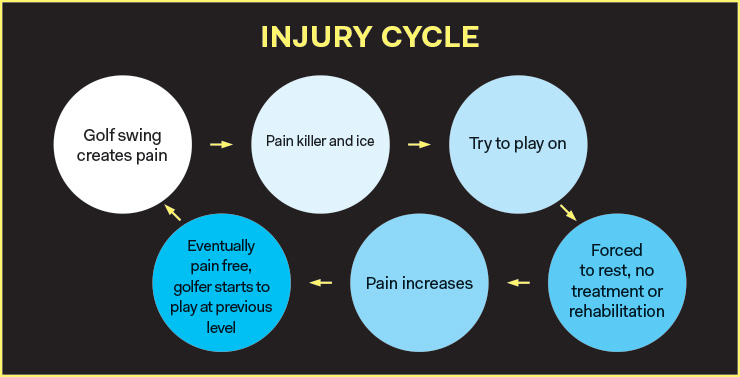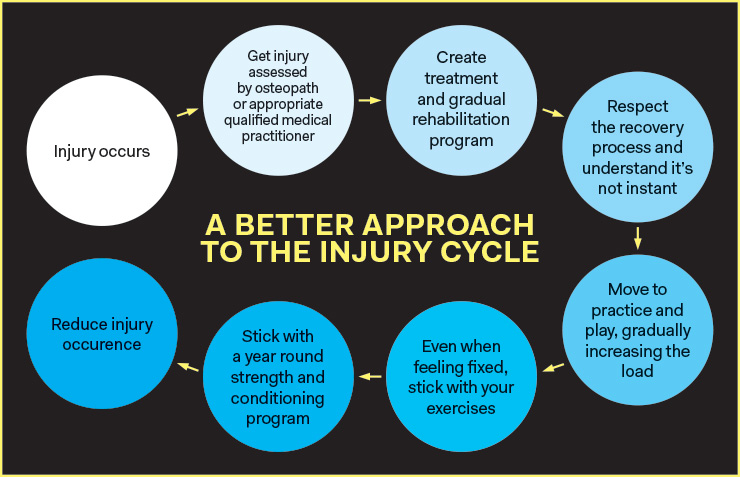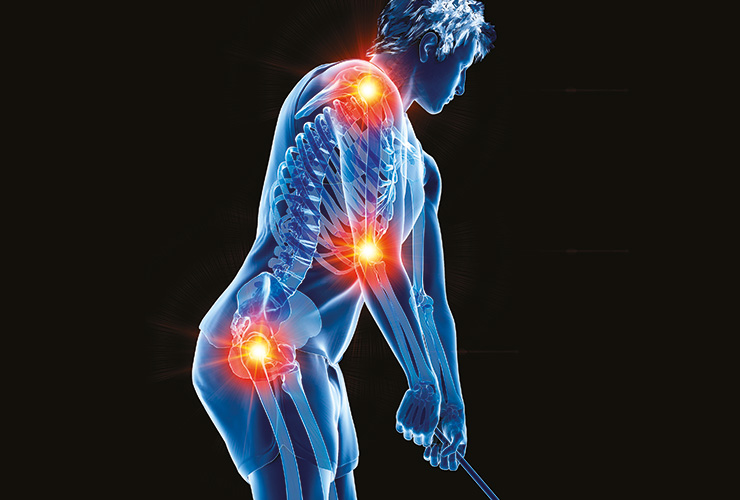Photos by Getty Images
After identifying the most common golf injuries last month, Optimal Fitness osteopath Russell Hill is now focused on ensuring you don’t fall into a perpetual injury cycle.
By Russell Hill
Injuries are sadly common in amateur golf. Data highlights that 28 percent of all players have back pain after every round, 35 percent will have sustained an injury in the last 12 months and 70 percent of these will result in the amateur missing play or practising due to the niggle.
It all equates to frustration and unnecessary cost. Your leisure time is precious enough without injury robbing you of a chance to play and those expensive membership fees are exempt from lost-time deductions.
It is even more annoying to keep re-injuring the same area of our body which leaves you pulling your hair out as it takes longer and longer each time to return to the game we all love.
So, how did you get into an injury cycle and how do we get out of it? The primary goal should be prevention which I will outline later. First off, we need to understand how and why common injuries occur.
An underappreciated scenario is when amateurs are trying to implement swing changes. The Titleist Performance Institute (TPI) has identified 12 suboptimal swing characteristics that are commonly occurring among golfers. These can be as a result of being self-taught and/or poor programming of our body. Each one of them can also be linked to poor movement patterns.
It is these poor movement patterns that makes us susceptible to injury which makes seeking the advice of a qualified golf coach vital before implementing swing changes. The TPI have developed a physical screen which can be easily conducted on a driving range to detect poor movement patterns and identify if you have the movement capacity to adopt these swing changes successfully. If you cannot adapt appropriately there are two options:
1. A good coach will be able to advise safe swing adaptions that counter these dysfunctions. This is a short term fix and not a long term solution for improving your golf or long term health.
2. Seek the appropriate physical advice from a qualified golf trainer (if there is no pain involved) or see an appropriate specialised osteopath or physiotherapist.
LOWER BACK PAIN
Lower back pain accounts for 36 percent of all injuries in amateur golfers. As I discussed in last month’s article, the golf swing is a chain reaction that requires a sequential integration of each body part and if there is dysfunction in one area, this might cause an overload in an adjacent area that has no ability to absorb this load. The lower back absorbs a large amount of rotational stresses in the swing and the lack of mobility or stability in the shoulders, hips, thoracic spine and ankles can overload the lower back and cause these breakdowns. Most golf injuries happen at the lambro-sacral joint as it absorbs a far greater rotational force than the rest of the lumbar spine. Injuries can occur in the disc, the facet joints, ligaments, or local musculature.

ELBOW, WRIST AND SHOULDER
The shoulder represents up to 19 percent, the hand and wrist 32 percent and the elbow 33 percent of all golfing injuries. The arm up into the thoracic spine is a continuum of an interdependent joint that is designed to allow the hand to be utilised in any space it needs to and inversely absorb any stress coming up from the hand into the shoulder and upper back. Any disruption in range of motion or strength will overload above and below causing a breakdown into pain. The most common injury is tendonitis in the elbow, either golfer’s elbow on the inside or tennis elbow, which is bizarrely more common in golfers, on the outside of the elbow. The other common injuries in these areas are shoulder slap tear, rotator cuff dysfunction, shoulder impingement and the hand and wrist are commonly affected by tendonitis.

KNEE
Knee injuries represent nine percent of all golf injuries and, according to leading U.S. orthopaedic MD Dr Timothy. Bollom, the lead leg absorbs 4½ to 5 times the body weight in the golf swing. Therefore, “it would be less stress overall on the knee to jog 18 holes than to play golf for 18 holes,” says Dr Bollom. This stress would be significantly more if the ankles and hips were functioning sub optimally.
HIPS
Hip issues are less common in golfers but can be devastating to a fluid and powerful swing. Hip dysfunction can be a predisposing factor to lower back, knee and ankle pain.
[divider] [/divider]
Conventional Approach
Conventionally, if we feel pain, we tend to reach for the medicine cabinet and take pain killers, anti-inflammatories, muscle relaxants or use ice or heat depending on past advice and past success. Is this really what is needed? This response is necessary at times and is not to be overlooked but the mindset is changing and being questioned. Inflammation is a natural body response to tissue damage and is vital in the repair and recovery of tissue and therefore reducing inflammation does not always help a speedy recovery. The same can be said for pain killers as pain is a response which warns your body of impending danger and prompts one to take the appropriate action or avoid a certain movement. By taking pain killers to cover up pain so you feel you can play golf might be prolonging your recovery and, at worst, increasing the tissue damage.
The Injury Cycle
The one known fact about injury is that the most common risk factor to sustaining an injury is past injury. I see people coming into the clinic time and again presenting with the same issues and the time between each visit can vary from several days/weeks to a few years. Often in these cases, the time between representing gradually shortens and unfortunately reoccurring issues can become more difficult to treat each time.

What I see so often is a golfer who comes in with mid-back pain. Here’s how it happens:
1. Onset of pain whilst trying to over-swing, or they use a highly compensated swing
2. Initially they use pain killers and either ice or heat to take the pain away
3. It reduces slightly and they think it’s ok so they go out and play golf again
4. The pain increases
5. A visit to their doctor where they are given stronger pain killers and they are told to rest. Occasionally they will be treated manually by an osteopath or physiotherapist but will fall into the 80 percentile who do not follow the appropriate exercise advice given
6. The pain reduces again to pain-free, but they then go back to their golf thinking they are fixed.
7. The pain reoccurs
Breaking The Pain Cycle
The most important first step to understanding that something needs to change is that pain is associated with dysfunction and without changing this dysfunction appropriately, you are unlikely to break the pain cycle.
The next action is to seek a certified osteopath, sports doctor, or appropriate physical therapist with experience in golf injuries and appropriate rehabilitation. It is important not only to get an accurate diagnosis but an accurate functional assessment to identify all predisposing factors. The first objective of treatment is to reduce the pain levels followed by a structured and progressive rehabilitation plan devised to help and improve the loading capacity of your body. It is important that the patient understands and respects that injuries take time to heal. As your body recovers, effective ‘back to play’ strategies should be implemented:
1. Chipping and half swings as opposed to long game work
2. Reducing the number of balls hit on the range
3. Shorter range sessions
4. More time putting. We all know we drive for show and putt for dough and most of us can still improve in that area of the game!

To conclude, the best way to avoid pain is to have a specific golf movement screening from one of the few qualified golf specialists in the Middle East who will devise a program to address any dysfunctions that might be either stopping you from improving or keeping you in a pain cycle that is only likely to get worse.
As I jest with patients, you have two choices. 1, you can do your exercise or 2, make your therapist rich”.
A former professional squash player and coach, Russell Hill qualified from the British School of Osteopathy at the age of 27. With his MENA Tour playing son Josh Hill, the world record holder as the youngest winner of an official WAGR event, developing into one of the hottest prospects in English golf, Russell has spent the past decade furthering his education to specialise in golf injury prevention, treatment, movement assessments, rehab and golf fitness. Hill Snr not only treats local golf enthusiasts but is the official provider to the MENA tour and treats European and LET players when they’re passing through the UAE.









